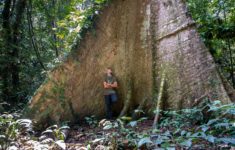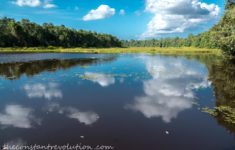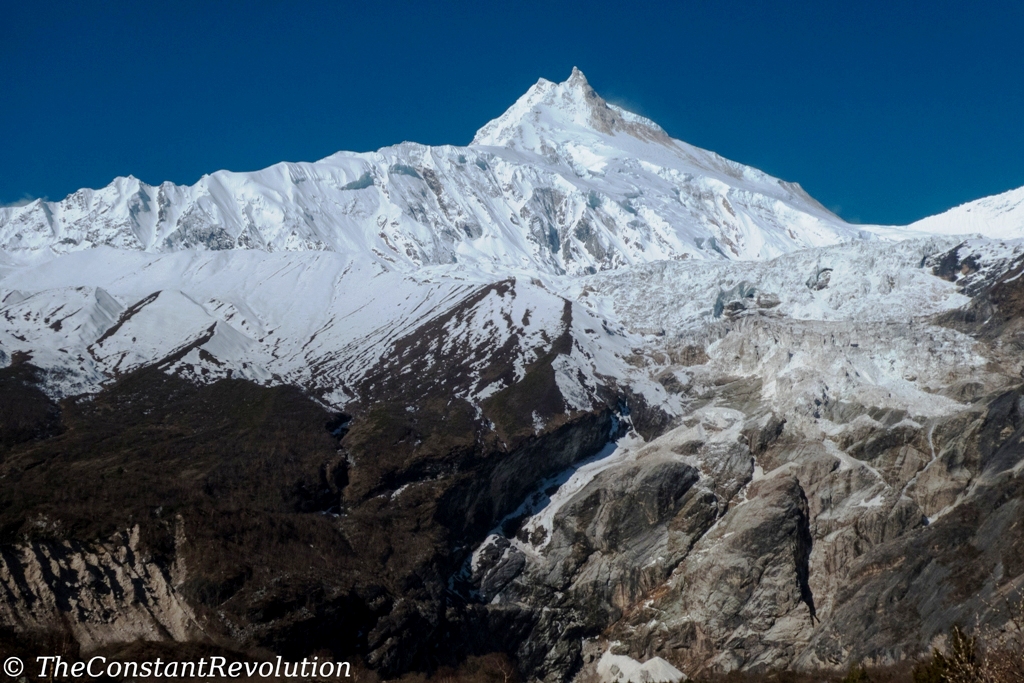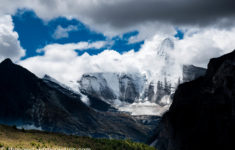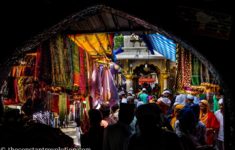In this post, I explain what, where and how you can spot the incredible wildlife of Sabah, where the overflowing sound of Borneo’s rainforest make up the largest orchestra ever provided by nature.
I have explored many Asian jungles during my travels and one thing that I have often, and sadly noticed, with the exception of Bardia National Park in Nepal, is their silence. I mean, not a complete silence, that would be a horror film. But the sound of jungles and forestry areas in Laos, Vietnam, China, Thailand, and Cambodia are limited to a few soloists – gibbons calling in the distance, the flapping wing of a rare hornbill – and mild background music, not quite in sync with each other.

Borneo is different. When you go anywhere near the rainforest, the sounds of nature are all around, powerful, overflowing, and uninterrupted. The estimated 222 mammals (including 44 endemic), 420 birds (37 endemic), 100 amphibians and 394 fish (19 endemic) in Borneo make up one of the largest orchestra nature can provide. (WWF data). The charm of this sound lies within the harmony of its wholeness as well as in trying to distinguish the distinctive features of its single components.
Luckily, despite all the issues concerning intensive logging starting in the 1950s and continuing through the 1980s, some pockets of biodiversity have been saved and preserved, and can be experienced. Incredibly, almost all of the components of the orchestra are still part of it, even the rarest ones haven’t retired yet. But a truly complete orchestra, most probably, will never be put together again.

Morning, day and night the rainforest in Borneo is sound: mesmerizing music to listen to over and over again, each time discovering a new melody, a different tone, a peculiar pitch. This makes Borneo one of the most incredible must-visit places for wildlife lovers.
I have described in details issue of conservation and reforestation in Sabah in a separated article. In this post, I’ll explain where are the best places to enjoy Borneo’s nature and spot wildlife in Sabah, for all budgets.
WHERE TO SEE WILDLIFE IN SABAH?
I am excluding, despite the usefulness of their work, the rehabilitation centres for orangutans or sun bears or other species, like the one in Sepilok. There, it is quite easy to see rare wildlife but first, I didn’t visit it, and second, I want to highlight only how to spot wildlife, well in the wild.
So, there are two ways to spot wildlife in Sabah:
The first way is to visit a location along the 500 Km long, croc-infested Kinabatangan river. This is mostly a lowland rainforest area with several micro topographies, home of the full range of Borneo’s wildlife, and surrounded almost completely by palm oil plantations. This area is indeed the most farmed one in Sabah, but few pockets of secondary forest (replanted forest after big fires ruined it in the 1980s) have been preserved, and some projects are working to create wider areas for wildlife to source food.
Secondary forests represent 50% of all Sabah’s land (that includes rivers, lakes etc..), while 40% is farmed (mostly in the Eastern part along the Kinabatangan river), and 10% is national parks.

The second way to spot wildlife in Sabah is indeed to visit one of the national parks, which are the remaining pockets of primary rainforest, also considered by many the oldest jungle in the world.
Secondary vs primary forest
Both primary and secondary forests offer the full range of jungle experiences and are home for all Sabah’s species. I believe it is worth visiting both, but there are important differences:
√ Costs: it is definitely cheaper to visit the Kinabatangan sites. National parks are expensive, if not luxurious.
√ Logistic: it is much easier to reach Kinabatangan river sites. National parks are far to reach, and often require long, rough rides on dirt roads.
√ Wildlife spotting: all in all the difference is not that big. If you spend enough time in both locations, with the help of guides, you can spot a lot of wildlife. However, it is a little easier on the Kinabatangan river, because of the possibility to go on river cruises, because the thickness of the jungle there allows for more visibility, and because the protected areas are much, much, much smaller.
√ Beauty: well, they are very different types of environment. Personally, I succumb to the charm of river life. But the sheer greenery and majestic beauty of the oldest jungle in the world is a spectacle not to be missed.
All in all, it depends on your time, budget and expectations. In the following, I will break it down into further details and provide specific sites info.
WHERE TO GO ON THE KINABATANGAN RIVER?
In my opinion, this is the easiest, cheapest and in some cases more Eco-friendly way to see wildlife in Sabah. A few wildlife sanctuaries are scattered around the 500 Km long Kinabatangan River, which cuts across Easter Sabah. I haven’t visited them all, but I can tell about a couple of possibilities.
Sukao and surroundings
The first place to see wildlife along the Kinabatangan is the well-known town of Sukao (and surroundings) in the Eastern part of the river. Mostly, here is where tourist agencies will send you if you book a package from, say, Sandakan or some other locations. It offers comforts such as luxury lodges and B&B, and a few lower budget options such as homestays or backpackers dorms. If you are on a budget and you have time, I would just go there or book only the accommodation, and then look for your river cruises and jungle tours on site.

All the opportunities to spot wildlife are there, just like everywhere else along the river. On the downside, you won’t be on your own, especially during high season. It is basically a village focusing on Kinabatangan related tourism, there are many accommodations and many operators working in the area. Costs depend on the type of accommodation you chose but tours, if you don’t book expensive packages through some agencies in advance, should not be expensive.
Honestly, I didn’t go there, I have just spoken with many people that did, and they were pretty happy with what they did and saw, but very few spotted the star of the Bornean orchestra: the orangutan.
Pin-Supu Forest Conservation Area
A great place to spot wildlife along the Kinabatangan is the Pin-Supu Forest Conservation area, situated right where the river crosses the main road that travels Sabah from north to south. The place is run by Community Ecotourism Cooperative (KOPEL) which is the only operator there. Yep, just one.
Now, I spent about a month volunteering with KOPEL, as the Eco-tourism business of this small community also funds their conservation and reforestation efforts in the area. I have explained in details the whole project in another post, including, at the end of it, all the possible activities for wildlife spotting and tree planting that can be carried out there.

So, I might be a little biased, because I loved the place, the forest and the people there, and I am sure you’d love them too. And I’ll also tell you why:
√ The Eco-camp is in the middle of the rainforest, in front of the Tungog lake, where the orchestra plays the most beautiful and relaxing melody all day and night without interruption. It can be reached only with a boat ride, there is no electricity and only bucket showers, it is Eco through and through. Yet, none of that is missed. Food is brought from the café in the village and it is yummy and abundant.

You’ll be able to see birds, lizards and mammals just by chilling on the deck in front of the beautiful scenery of the lake, in itself unforgettable. Monitor lizards, civets, owls, several types of monkeys, squirrels and the crocs inhabiting the lake are regular sights around camp. If Eco-camp is not for you, homestays at the village are also an option. No luxury lodges or B&B here, it is local life only, which is, in my opinion, an added value for spending here two or three days.

√This place is the cheapest way to see wildlife in Sabah, all of it: while I was there I saw wild orangutans five times both in the forest around camp and during morning cruises on the river. I saw the elusive slow loris many times during night walks, along with several types of civet cats, mouse deer, Malay badger and other mammals. The cute western tarsier has been seen a couple of times, not by my eyes, unfortunately. I saw huge crocs on the river all the time, and myriads of hornbills, kingfishers and other types of birds. The list is long.

√ The Eco-tourism activities here are funding conservation and reforestation efforts in the area, to which you would contribute. You can even plant your own tree if you so desire. I mean, do you need another reason?
√ Last but not least, the People – with a capital P – are honest, fun, and love their jobs and what they have built there. It’s a community run operation and a great example of sustainability.
The Pin-Supu Forest Conservation Area is a great place to spot wildlife in a budget-friendly, Eco-oriented way. It is easy to reach and the people there are really nice. As you can imagine, I am a fan, and I highly recommend a visit!
WHICH NATIONAL PARK IS BETTER TO SPOT WILDLIFE?
In Sabah, there are several pockets of primary forest, also considered the oldest jungle in the world, making up for 10% of the territory. The largest of all is Mount Kinabalu National Park, in the northern part of the region. This UNESCO site is a great place for birdwatching and to observe the biodiversity of the flora, but when it comes to mammals they are very unlikely to be seen, although many species are believed to still live there, somewhere and in a few numbers.
Instead, the easiest way to have both primary rainforest and wildlife spotting opportunities is to visit either Tabin Wildlife Reserve, south-east Sabah, or Danum Valley Conservation Area, south-west. Both these national parks can be reached from Lahad Datu, they are both hard to reach with long and rough dirt road rides, and in both cases expensive.
In Tabin, there is only one luxury lodge operating, very expensive place, definitely out of my budget and travelling philosophy. In Danum Valley there is a similar type of lodge, but also a more affordable kind of backpacker solution at the Field Centre, which was originally set up for researchers and then opened up to tourists as well. So I went for this option.
How to visit Danum Valley Field Centre
Danum Valley Field Centre is affordable so to speak. I went to visit it for two nights: accommodation at the hostel in a dorm (95 Ringgit p/n), I brought my own breakfast and ate there one lunch and two dinners, local buffet type, and I had to pay for few guided tours as it is compulsory to have a ranger with you in the jungle. With transport organised by the Field Centre, which is the cheapest option, I ended up paying the equivalent of € 130 ($ 150). For basically one day and a half spent there.

Not bad, although outside backpackers budget. To make things worse, the Field Centre office in Lahad Datu is very unorganised, it is hard to book and communicate with them. If you are planning a visit, book transport with them in advance, because they have only one small minivan that travels back and forth once per day, and even though there are many beds in the hostel, seats on the minivan are limited. The alternative is to go with private transport, which makes the trip much more expensive.
From the Lahad Datu’s office (which is close to the airport, all big buses stop there or you can ask a minivan to drop you there if needed), the trip to the field centre lasts 2h 30 min.
All in all I have enjoyed my visit to Danum Valley. The jungle there is really majestic, the greenery is something not to believe, it can only be seen. I spotted wildlife, but nothing “special”. Although while I was there, there has been two orangutan sightings, and the week before there has been clouded leopard sightings and the Bornean endemic pygmy elephants. So, given the right amount of time and luck, the place is definitely good to spot lots of wildlife, and bad for your wallet.

THE SOUNDS OF THE JUNGLE
Here is what you can do and see along the Kinabatangan River and/or in Danum Valley, the two places where I have spent some time trying to spot wildlife:
√ Jungle walks, everywhere, at any time
Morning, day and night, the orchestra plays in the rainforest, and a trek is the best way to immerse yourself in the music, listen to the harmony, and try to spot those soloists that you are looking for. The whistle of a rare bird like the giant pitta. The call of endemic Bornean gibbons or the sound the many types of monkeys jumping from a tree to another. The high-pitched chirping of one of the seven types of squirrels.

That imperceptible, different pattern in the movement of branches, leaves, and bushes that you can’t see, but you can hear. So, the orangutan silently moves from a branch to the other on top of the canopy, looking for fruit to eat, and if you are not listening most likely you will pass just below it without noticing its presence. It isn’t easy, but after a while, you start paying attention to every single sound, every single disarray in the overall harmony that tells you something is different, something is happening.
A totally different sound can be heard after dark, when most of the mammals and other creatures are active in the jungle. The call of an owl, the soft slithering of a snake, or the glittering eyes of a slow loris, the third ape after orangutan and gibbon living in Borneo, up in the trees. At this time both ears and eyes play an important role in spotting wildlife, as well as reducing your own noise to a minimum. The harmony is delicate, its balance easily ruptured. You need to become jungle in order to see the life within it.
Night walks are definitely my favourite. You can spot badgers, many types of deer, civet cats, snakes, lots of birds, the super cute mini-monkey western tarsier, lots of weird bugs, frogs, and lizards, and so much more. If you are really lucky, you can spot a clouded leopard, the biggest cat in Borneo, a real possibility; a sun bear, very rare but more active during the night; or the dream of my life, a pangolin, almost an impossibility.

√ River cruises
Sunrise and sunset cruises are a classic of the Kinabatangan river, and perhaps the easiest way to spot many species of birds, amphibians and mammals. Regular sights include the Bornean endemic Proboscis monkey, estuarine saltwater crocodiles that can grow up to 6m long, Eagles, Hornbills (there are 7 types of them), Kingfishers, Bee-eaters and many other birds, and if you are lucky, of course, the orangutan.

√ Car safaris
This is a speciality of national parks such as Danum Valley, which are much bigger. Sunrise, sunset and night safaris are organised by the guides. With a good spotter lots can be seen, including clouded leopards, slow loris, and, why not, sun bears. Most of the time however you’ll be much farther away from the animals compared to jungle walks or river cruises.
√ Cave and waterfalls exploration
In some areas, there are caves to explore, like in Pin-Supu, which are inhabited by bats and other spooky creatures, such as tarantulas and long-legged centipedes. In some other places, like Danum Valley, jungle treks lead to pools and waterfalls where you can swim.

√Jungle camping
If you are the adventurous type, and you don’t mind mosquito, fire ants, leeches and other bugs too much, then you can go for one or more days camping in the jungle. Every campsite is organised differently, sometimes there are facilities and bunk beds, some other times there is nothing at all and you’ll have to sleep in a hammock tied to some trees. This, by the way, is quite an amazing experience. Camping in the jungle allows to reach more remote areas and increases the possibilities to spot rare wildlife. It is also more demanding both physically and psychologically.
√ Sunrise views
Are you an early riser? Sometimes there is the possibility to climb to the top of limestone outcrops, or some human-made decks, and check a most beautiful, misty sunrise above the jungle. And when the light comes, check the surroundings and see what kind of wildlife was lurking around.

√ How about the elephants?
The endemic, mega cute and endangered pygmy elephants can be spotted in any of the places and ways mentioned above, night or day, depending on the season. It’s very hard though. There are so few of them left in Sabah (WWF says 1,500 between Borneo and Sumatra, I have been told only 100 in Sabah) which are all monitored electronically. So, normally parks and conservation areas should know if the elephants are around or can be expected.
THE FINAL CONCERT?
So, the orchestra is complete, the melody is final, unchanging, locked in a never-ending harmonious concert…
Not quite, as everything changes, and in the past few decades much faster than what it should have. This body of sounds is already crippled by one important component, a subspecies of the Sumatran Rhino, which has retired forever. Some other soloists are just rare appearances and could soon give up: the pangolin, the bear, the elephants, the slow loris… and slowly, inevitably, the silence.
They have a little space to play, little air to breathe, that’s true. But they would keep going, I am sure, they would struggle to adapt if only left in peace. Instead, they are chased and hunted, for vanity and superstition, as trophies, or just for fun. That is too much, that they cannot fight on their own. Let’s not forget this, every time we listen to the sound of Borneo’s jungles.


